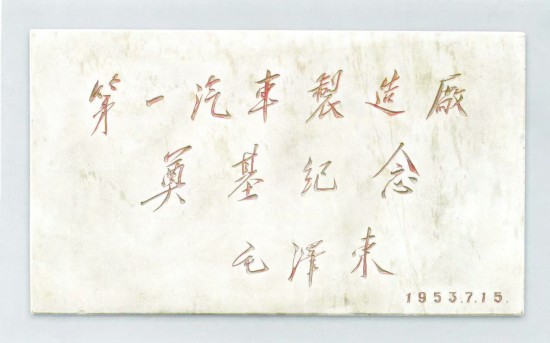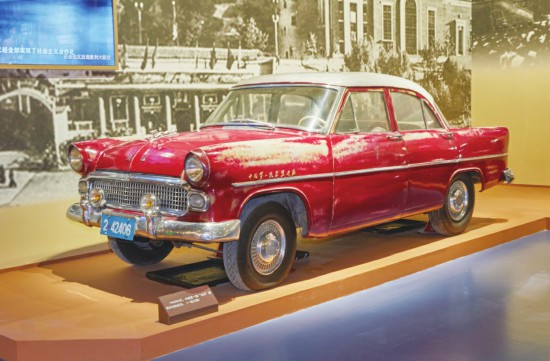"In the car we made ourselves!"

The cornerstone of the First Automobile Factory engraved with Mao Zedong’s inscription

In May 1958, China’s first "Dongfeng" brand car was successfully trial-produced
In the early days of the founding of New China, Mao Zedong said: What can we make now? We can make tables and chairs, tea bowls and pots, grow grain, grind flour, and make paper, but we can’t make a car, an airplane, a tank, or a tractor.
Achieving socialist industrialization is a natural requirement and a necessary condition for a country to become independent and prosperous, and is the foundation and premise for building a modern socialist power. During the "First Five-Year Plan" period, the state concentrated its resources to establish an independent and relatively complete industrial system and national economic system in a short period of time, achieving rapid growth of the national economy, which was of far-reaching significance to China’s later industrial development.
The cornerstone of the "First Automobile Factory Groundbreaking Memorial" displayed in the History Exhibition Hall of the Communist Party of China, inscribed by Mao Zedong, is 120.5 centimeters long, 70 centimeters high, 5.5 centimeters thick, and weighs 250 kilograms. The texture of white marble is an important witness to the history of industrial construction in New China.
On June 15, 1953, Mao Zedong delivered a speech at the Politburo meeting of the Central Committee, formally proposing the general line for the transition period. Faced with the lack of funds, technology and talents, to establish China’s own industrial system, it is necessary to formulate detailed plans and concentrate the limited human, material and financial resources to build a number of urgently needed major projects.
Under the personal guidance of Mao Zedong and the direct help of the Soviet Union, the first five-year plan was formulated by Zhou Enlai, Chen Yun, Li Fuchun, etc., and the strategic decision to give priority to the development of heavy industry was made. Adhering to the policy of "self-reliance first, and foreign aid as a supplement", the preliminary industrial layout was completed. During the "First Five-Year Plan" period, a total of 694 large and medium-sized construction projects were arranged, and 921 were actually constructed, including 156 construction projects aided by the Soviet Union, focusing on the development of heavy industry, energy, raw materials, machine manufacturing and other basic industrial projects.
In 1953, the People’s Daily published a New Year’s Day editorial announcing that China had begun to implement the first five-year plan, calling on the people of the whole country to work together with one heart and one mind and actively strive for the realization of industrialization. Building a prosperous and strong modern industrial country is the dream of several generations of Chinese sons and daughters. Faced with the "poor and white" family background and the heavy blockade in the world, the Chinese people have a common dream, a foothold in the sky, and energy. Facing difficulties, the Chinese people have carried out large-scale industrial construction in full swing across the country.
As early as Mao Zedong’s first visit to the Soviet Union, he visited the Stalin Automobile Factory. At that time, he pointed to the cars that drove down the assembly line and said to his entourage: "We also want to have such a large factory!" On July 15, 1953, the first automobile industrial base of New China, Changchun First Automobile Factory, held a groundbreaking ceremony in a barren suburb of Changchun. Mao Zedong personally wrote the cornerstone inscription. Instead of adopting the proposed "Mao Zedong Automobile Factory" or "New China Automobile Factory", he named it the First Automobile Factory because he said: "We will soon have a second and a third."
600 million yuan was invested in the construction of the FAW, which is equivalent to one yuan for 600 million people in the country. On July 13, 1956, we forcefully announced that the first car in New China was successfully trial-produced. "From today onwards, the history of China’s inability to manufacture cars is over, and our own cars will be driven out of here more and more day by day." Mao Zedong personally picked up the pen and wrote the word "Liberation". The first batch of 12 "Liberation" brand cars drove off the assembly line and became an eternal and precious freeze frame in the history of the Republic. The rejoicing masses, as the song made up at that time sang: "Looking forward to the stars and the moon, the domestic car that I hoped for really left the factory." Just one year later, Changchun FAW completed the production of 4,000 vehicles stipulated in the first five-year plan six months and five days ahead of schedule.
In 1958, the Changchun FAW Factory produced China’s first domestically produced car, the Dongfeng brand car. After the manufacture was completed, it was instructed by the central government to be shipped by train to Beijing. When it drove off the platform, it was almost unable to leave the Beijing Railway Station due to the enthusiastic crowd competing to watch. Dongfeng originated from Mao Zedong’s famous statement on the international situation – "Dongfeng overwhelms the westerly wind". The word "Dongfeng" on the front of the car was originally Chinese pinyin. On the eve of the Dongfeng car arriving in Beijing and driving into Zhongnanhai, according to the suggestion of the then director of the General Office of the Central Committee ***, in order to highlight the cars produced by the Chinese themselves and replace them with Chinese characters, FAW staff went to the People’s Daily overnight to photocopy Mao Zedong’s original handwriting of "Dongfeng overwhelms the westerly wind". It was replaced in an auto repair shop in Dengshikou, and a golden dragon was about to be vacated in the front of the car, which was very Chinese. Mao Zedong took it in person and said happily: "We took a car made by ourselves!"
While the automobile industry was booming, various industrial categories were also in full swing. On December 26, 1953, the three major projects of Angang, consisting of a large rolling mill, a seamless steel pipe plant, and a No. 7 blast furnace, were completed and put into operation. At the same time, new steel production bases were deployed, and a new layout of the steel industry in New China was initially formed. The petroleum industry, chemical industry, and weapons industry have all achieved a certain degree of development, focusing on the construction of emerging industrial sectors such as aviation and electronics, and the creation of new cutting-edge industries in the nuclear and aerospace industries. In 1956, Shenyang Aircraft Factory produced the first new jet fighter; in 1958, the first Dongfanghong tractor was born in the first tractor factory located in Luoyang City… In that fiery construction era, China, which used to import iron nails and matches, achieved one zero breakthrough after another, and gradually established an industrial economic system under the leadership of the socialist state-run economy, which made our country’s industrial economy recover and develop rapidly under extremely difficult conditions.
Today, steel dragons meander vertically and horizontally, phoenixes spread their wings at Daxing Airport, Chang’e Tiangong catches the moon in nine days, and flood dragons and snow dragons catch turtles in five oceans. Over the past 70 years, China’s industry has achieved one "zero breakthrough" after another, and Chinese manufacturing and Chinese creation are gradually leading the world.
(History Exhibition Hall of the Communist Party of China, contributed)